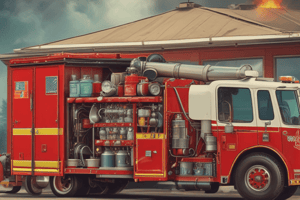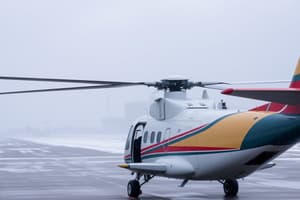Podcast
Questions and Answers
What is the decision height specified for a Category I operation?
What is the decision height specified for a Category I operation?
- Not lower than 300 ft
- Not lower than 50 ft
- Not lower than 100 ft
- Not lower than 200 ft (correct)
Which operation uses a decision height lower than 50 ft?
Which operation uses a decision height lower than 50 ft?
- Category III B (correct)
- Category II
- Category III A
- Category I
What is the minimum runway visual range (RVR) required for Category III A operations?
What is the minimum runway visual range (RVR) required for Category III A operations?
- Not less than 200 m (correct)
- Not less than 75 m
- Not less than 550 m
- Not less than 300 m
What determines the category of operation when decision height and runway visual range do not match?
What determines the category of operation when decision height and runway visual range do not match?
What does Alert Height signify in the operational context?
What does Alert Height signify in the operational context?
In a circling approach, what is primarily used to position the aircraft for landing?
In a circling approach, what is primarily used to position the aircraft for landing?
What defines a Category II operation's decision height?
What defines a Category II operation's decision height?
What is the lowest reported cloud level referred to as?
What is the lowest reported cloud level referred to as?
What determines the LVTO minima at an aerodrome?
What determines the LVTO minima at an aerodrome?
Which of the following is NOT a factor in determining the minimum decision height for a CAT II approach?
Which of the following is NOT a factor in determining the minimum decision height for a CAT II approach?
Where will the operating minima for a CAT II approach be shown?
Where will the operating minima for a CAT II approach be shown?
In CAT II operations, when can a precision approach be continued below the decision height?
In CAT II operations, when can a precision approach be continued below the decision height?
What is the minimum decision height for a CAT II approach if no other minima are specified?
What is the minimum decision height for a CAT II approach if no other minima are specified?
Which of the following is an essential visual reference required for a CAT II approach?
Which of the following is an essential visual reference required for a CAT II approach?
Which statement about CAT III operations is correct?
Which statement about CAT III operations is correct?
What does the acronym DVH represent in the context of CAT II operations?
What does the acronym DVH represent in the context of CAT II operations?
In what weather conditions should landing lights not normally be used?
In what weather conditions should landing lights not normally be used?
What is the primary responsibility of the Pilot Flying (PF) during an approach?
What is the primary responsibility of the Pilot Flying (PF) during an approach?
How should the Commander prepare when approaching the Decision Height (DH)?
How should the Commander prepare when approaching the Decision Height (DH)?
What is required for approaches without a Decision Height (DH)?
What is required for approaches without a Decision Height (DH)?
What must a pilot do if visual references become insufficient before touchdown during an approach with DH?
What must a pilot do if visual references become insufficient before touchdown during an approach with DH?
What is a potential risk of initiating a go-around close to the ground?
What is a potential risk of initiating a go-around close to the ground?
What is the role of the Pilot Not Flying (PNF) during the approach?
What is the role of the Pilot Not Flying (PNF) during the approach?
For approaches without a DH, what primary factor dictates the decision to continue?
For approaches without a DH, what primary factor dictates the decision to continue?
What should a pilot do if the required visual reference is lost after touchdown?
What should a pilot do if the required visual reference is lost after touchdown?
Which response is appropriate to a failure of any system during approach?
Which response is appropriate to a failure of any system during approach?
Who is responsible for flying during an autoland operation below CAT I minima?
Who is responsible for flying during an autoland operation below CAT I minima?
What must be done if there is an abnormality during practice autoland?
What must be done if there is an abnormality during practice autoland?
What is required of operators during CAT II and CAT III operations?
What is required of operators during CAT II and CAT III operations?
For practices involving autoland, which condition is NOT required?
For practices involving autoland, which condition is NOT required?
What is an acceptable response if achieving the planned minima is not possible?
What is an acceptable response if achieving the planned minima is not possible?
Which approach procedures should all approaches preceding an autoland comply with?
Which approach procedures should all approaches preceding an autoland comply with?
What defines cloud ceiling in relation to an aerodrome?
What defines cloud ceiling in relation to an aerodrome?
What is the main difference between Decision Altitude (DA) and Decision Height (DH)?
What is the main difference between Decision Altitude (DA) and Decision Height (DH)?
What characterizes a Fail-Passive Flight Control System?
What characterizes a Fail-Passive Flight Control System?
How is a Fail-Operational Flight Control System defined?
How is a Fail-Operational Flight Control System defined?
What is the purpose of a Fail-Operational Hybrid Landing System?
What is the purpose of a Fail-Operational Hybrid Landing System?
When does the Final Approach in an instrument approach procedure begin?
When does the Final Approach in an instrument approach procedure begin?
What does a pilot do in the event of a failure in a Fail-Passive automatic flight control system?
What does a pilot do in the event of a failure in a Fail-Passive automatic flight control system?
What is the significance of alert height in a Fail-Operational Flight Control System?
What is the significance of alert height in a Fail-Operational Flight Control System?
What must a pilot achieve before continuing an approach below the decision height in Category IIIB operations?
What must a pilot achieve before continuing an approach below the decision height in Category IIIB operations?
Under what visibility condition can an aerodrome be used for LVOs?
Under what visibility condition can an aerodrome be used for LVOs?
What is the minimum RVR for the mid-point of a runway according to the guidelines?
What is the minimum RVR for the mid-point of a runway according to the guidelines?
What type of landing system is mentioned as not currently used in AeroTrans Cargo operations?
What type of landing system is mentioned as not currently used in AeroTrans Cargo operations?
Which of the following accurately describes the controlling RVR measurement?
Which of the following accurately describes the controlling RVR measurement?
When equivalent procedures to LVP are established at a foreign aerodrome, what is necessary?
When equivalent procedures to LVP are established at a foreign aerodrome, what is necessary?
Which of the following statements about minimum RVR values is correct?
Which of the following statements about minimum RVR values is correct?
What action must a pilot take if decision height is not applicable during Category III operations?
What action must a pilot take if decision height is not applicable during Category III operations?
Flashcards
Cloud Ceiling (BKN)
Cloud Ceiling (BKN)
The vertical distance from the airport's elevation to the lowest visible cloud that covers more than half the sky above the airport.
Decision Altitude (DA) / Decision Height (DH)
Decision Altitude (DA) / Decision Height (DH)
The specific altitude where the pilot needs to initiate a missed approach if visual references for landing aren't available.
Fail-Passive Flight Control System
Fail-Passive Flight Control System
A flight control system that maintains control even if one part fails; the aircraft won't have a significant out-of-trim condition or deviate from its path, but the pilot takes over manually.
Fail-Operational Flight Control System
Fail-Operational Flight Control System
Signup and view all the flashcards
Fail-Operational Hybrid Landing System
Fail-Operational Hybrid Landing System
Signup and view all the flashcards
Final Approach
Final Approach
Signup and view all the flashcards
LVTO Operating Minima
LVTO Operating Minima
Signup and view all the flashcards
Where to Find LVTO Minima
Where to Find LVTO Minima
Signup and view all the flashcards
CAT II Operating Minima Purpose
CAT II Operating Minima Purpose
Signup and view all the flashcards
CAT II Minima Presentation
CAT II Minima Presentation
Signup and view all the flashcards
Required Visual Reference for CAT II
Required Visual Reference for CAT II
Signup and view all the flashcards
CAT III Operating Minima
CAT III Operating Minima
Signup and view all the flashcards
Decision Height (DH) Limits for CAT II
Decision Height (DH) Limits for CAT II
Signup and view all the flashcards
Visual Reference Requirements for CAT II
Visual Reference Requirements for CAT II
Signup and view all the flashcards
Alert Height
Alert Height
Signup and view all the flashcards
Category I (CAT I) Operation
Category I (CAT I) Operation
Signup and view all the flashcards
Category II (CAT II) Operation
Category II (CAT II) Operation
Signup and view all the flashcards
Category III (CAT III) Operation
Category III (CAT III) Operation
Signup and view all the flashcards
Category IIIA (CAT IIIA) Operation
Category IIIA (CAT IIIA) Operation
Signup and view all the flashcards
Category IIIB (CAT IIIB) Operation
Category IIIB (CAT IIIB) Operation
Signup and view all the flashcards
Categories of Aircraft
Categories of Aircraft
Signup and view all the flashcards
Circling Approach
Circling Approach
Signup and view all the flashcards
Visual Reference Lost After Touchdown
Visual Reference Lost After Touchdown
Signup and view all the flashcards
AFDS Failure During Approach
AFDS Failure During Approach
Signup and view all the flashcards
Autoland Below CAT I Minima
Autoland Below CAT I Minima
Signup and view all the flashcards
Role Reversal in Autoland
Role Reversal in Autoland
Signup and view all the flashcards
Approach Procedures Before Autoland
Approach Procedures Before Autoland
Signup and view all the flashcards
Mandatory Autoland
Mandatory Autoland
Signup and view all the flashcards
Autoland Practice
Autoland Practice
Signup and view all the flashcards
CAT II/III Operations Monitoring
CAT II/III Operations Monitoring
Signup and view all the flashcards
Category IIIB Approach with Fail-Operational Systems
Category IIIB Approach with Fail-Operational Systems
Signup and view all the flashcards
Aerodrome Requirements for Low Visibility Operations (LVOs)
Aerodrome Requirements for Low Visibility Operations (LVOs)
Signup and view all the flashcards
Equivalent Procedures for Foreign Aerodromes
Equivalent Procedures for Foreign Aerodromes
Signup and view all the flashcards
Runway Visual Range (RVR) Measurement System
Runway Visual Range (RVR) Measurement System
Signup and view all the flashcards
RVR Measurement Locations
RVR Measurement Locations
Signup and view all the flashcards
Controlling RVR Values
Controlling RVR Values
Signup and view all the flashcards
Minimum RVR Values for Landing Operations
Minimum RVR Values for Landing Operations
Signup and view all the flashcards
Minimum RVR for Touchdown Zone
Minimum RVR for Touchdown Zone
Signup and view all the flashcards
Landing lights in CAT II or CAT III
Landing lights in CAT II or CAT III
Signup and view all the flashcards
Pilot Flying vs. Pilot Not Flying responsibilities
Pilot Flying vs. Pilot Not Flying responsibilities
Signup and view all the flashcards
Decision Height (DH)
Decision Height (DH)
Signup and view all the flashcards
DH decision preparation
DH decision preparation
Signup and view all the flashcards
Approaches without a Decision Height (DH)
Approaches without a Decision Height (DH)
Signup and view all the flashcards
Approach quality and visual references
Approach quality and visual references
Signup and view all the flashcards
Loss of visual references after DH
Loss of visual references after DH
Signup and view all the flashcards
Go-around near the ground
Go-around near the ground
Signup and view all the flashcards
Study Notes
All Weather Operations
- Terminology:
- Alert Height: The height above the runway where a Category III approach is stopped, and a missed approach is started if a failure occurs (specific to aircraft type).
- Category I (CAT I) Operation: Precision instrument approach and landing using ILS/MLS with a minimum decision height of 200 ft. and a minimum runway visual range (RVR) of 550 m.
- Category II (CAT II) Operation: A precision approach and landing using ILS/MLS, with a decision height below 200 ft (minimum 100 ft), and a minimum RVR of 300 meters (1000 ft.).
- Category III (CAT III) Operation: Subdivided into CAT III A and CAT III B.
- Category III A: Decision height below 100 ft, with minimum RVR of 200 m.
- Category III B: Decision height below 50 ft (or no decision height), with minimum RVR of 75 m, but not less than 200 m.
- Circling Approach: A visual instrument approach to land on a runway not positioned for a straight approach.
- Cloud Base: The lowest reported cloud level (FEW).
- Cloud Ceiling: The height from the aerodrome to the cloud base (BKN, or broken clouds).
- Decision Altitude (DA) / Height (DH): The altitude/height, where a missed approach is initiated if required visual references are not established (DA=MSL, DH=Threshold elevation)
- Fail-passive Flight Control System: A flight control system with no significant out-of-trim condition or deviation of flight path during a failure.
Additional Terms
- Fail-Operational Flight Control System: Flight control system where a failure or malfunction, below alert height, can be completed automatically.
- Fail-Operational Hybrid Landing System: System with a primary automatic landing system and a secondary independent guidance system.
- Final Approach: Part of the instrument approach procedure that commences from a final approach fix or point.
- Low Visibility Operations (LVO): Take-offs and approaches with RVR below 400 m.
- Minimum Descent Altitude/Height (MDA/H): The altitude/height when a non-precision approach will prevent descent without visual reference.
- Missed Approach Point (MAPt): Point in the approach procedure where the missed approach procedure must be initiated.
- Non-Precision Approach and Landing Operation: Instrument approach and landing without using electronic glide path guidance.
- Obstacle Clearance Altitude/Height (OCA/H): The lowest altitude/height above an elevation level that is used in compliance criteria.
- Obstacle Clearance Limit (OCL): Height above the aerodrome elevation, where the minimum vertical obstacle clearance cannot be maintained.
Other Operational Details
- Precision Approach and Landing Operation: Instrument approach and landing using high precision azimuth and glide path guidance.
- Required Visual Reference (RVR): The amount of runway visible to the pilot in relation to the desired flight path.
- Runway Visual Range (RVR): The distance a runway surface marking or lights can be seen from the centreline of a runway.
- Visual Approach: An instrument approach procedure using visual references to terrain.
- Operating Minima: (for non-precision and Cat I operations) determined in accordance with other operation parameters.
- Low Visibility Take-Off (LVTO): Operations with RVR less than 400 m.
- Low Visibility Taxi (LVTO): Operations for taxiing in low visibility conditions.
Runway Visual Range (RVR) Requirements
- RVR Measurements: Provided by calibrated transmissometers, considering ambient light and runway lights.
- Touchdown Zone (TDZ): Controls the minimum RVR.
- Mid-runway portion (MID) and rollout portion/stop end (RO) - provide control.
Aircraft Stabilization on Final Approach
- Steps to be taken by 1000 ft HAA (IMC/VMC)
- Speed maintenance between Vref and Vref +20
- Vertical speed less than 1000ft/min
- Bank angle less than 15 degrees
- Thrust above idle and appropriate landing configuration.
- Position for touchdown zone.
Autoland Operations
- Only permissible on runways with certified ILS equipment for CAT II and CAT III operations.
- Pilot flying and pilot non-flying duties (roles not to be reversed).
Studying That Suits You
Use AI to generate personalized quizzes and flashcards to suit your learning preferences.



